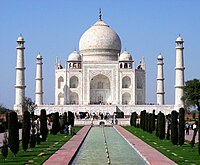Monument: Difference between revisions
Luckas-bot (talk | contribs) m robot Adding: te:స్మారక చిహ్నం |
|||
| Line 43: | Line 43: | ||
*[[National Monuments Record]] the public archive of [[English Heritage]], holds data on England's monuments |
*[[National Monuments Record]] the public archive of [[English Heritage]], holds data on England's monuments |
||
*[[Monumental sculpture]] |
*[[Monumental sculpture]] |
||
*[[Antiquities Act]] |
|||
== References == |
== References == |
||
Revision as of 20:55, 17 August 2010




A monument is a type of structure either explicitly created to commemorate a person or important event or which has become important to a social group as a part of their remembrance of past events. They are frequently used to improve the appearance of a city or location. Cities that are planned such as Washington D.C., New Delhi and Brasília are often built around monuments. The Washington Monument's location (and vertical geometry, though not physical detail) was conceived to help organize public space in the city before it was ever connected with George Washington. Older cities have monuments placed at locations that are already important or are sometimes redesigned to focus on one. As Shelley suggested in his famous poem "Ozymandias" ("Look on my works, ye Mighty, and despair!"), the purpose of monuments is very often to impress or awe. In English the word "monumental" is often used in reference to something of extraordinary size and power. The word comes from the Latin "monere," which means 'to remind' or 'to warn.'
Functional structures made notable by their age, size or historic significance can also be regarded as monuments. This can happen because of great age and size, as in the case of the Great Wall of China, or because an event of great import occurred there such as the village of Oradour-sur-Glane in France. Many countries use Ancient monument or similar terms for the official designation of protected structures or archeological sites which may originally have been ordinary domestic houses or other buildings.
Monuments are also often designed to convey historical or political information. They can be used to reinforce the primacy of contemporary political power, such as the column of Trajan or the numerous statues of Lenin in the Soviet Union. They can be used to educate the populace about important events or figures from the past, such as in the renaming of the old General Post Office Building in New York City to the James A. Farley Building (James Farley Post Office), after former Postmaster General James Farley.
The social meanings of monuments are rarely fixed and certain and are frequently 'contested' by different social groups. As an example whilst the former East German socialist state may have seen the Berlin Wall as a means of 'protection' from the ideological impurity of the west, dissidents and others would often argue that it was symbolic of the inherent repression and paranoia of that state. This contention of meaning is a central theme of modern 'post processual' archaeological discourse.
Monuments have been created for thousands of years, and they are often the most durable and famous symbols of ancient civilizations. The Egyptian Pyramids, the Greek Parthenon, and the Moai of Easter Island have become symbols of their civilizations. In more recent times, monumental structures such as the Statue of Liberty and Eiffel Tower have become iconic emblems of modern nation-states. The term monumentality relates to the symbolic status and physical presence of a monument.
Until recently, it was customary for archaeologists to study large monuments and pay less attention to the everyday lives of the societies that created them. New ideas about what constitutes the archaeological record have revealed that certain legislative and theoretical approaches to the subject are too focused on earlier definitions of monuments. An example has been the United Kingdom's Scheduled Ancient Monument laws.
Types of monuments
- Buildings designed as iconic landmarks
- Church monuments to commemorate the dead, above or near their grave, often featuring an effigy
- Cenotaphs and memorials to commemorate the dead, usually war casualties - e.g. Vimy Ridge Memorial and India Gate
- Columns, often topped with a statue - e.g. Nelson's Column in London
- Grave stones constitute small monuments to a dead person
- Mausoleums and tombs to inter the dead - e.g. the Great Pyramid and Taj Mahal
- Monoliths erected for religious or commemorative purposes - e.g. Stonehenge
- Mounds erected to commemorate great leaders or events - e.g. Kościuszko Mound
- Obelisks usually erected to commemorate great leaders - e.g. the Washington Monument, Monas
- Statues of famous individuals or symbols - e.g. Statue of Liberty
- Temples or religious structures built for pilgrimage, ritual or commemorative purposes - e.g. Borobudur, Kaaba
- Terminating vista, layout design for urban monuments
- Triumphal arches, almost always to commemorate military successes - e.g. the Arc de Triomphe
- Entire areas established as memorials to commemorate wartime atrocities or notably bloody battles - e.g. Oradour-sur-Glane or the battlefields at Gettysburg, Pennsylvania, Sekigahara and Borodino
- On occasion, monuments also refer to areas of special natural beauty
See also
- Memorial
- National memorial
- National monument (disambiguation)
- National Monuments Record the public archive of English Heritage, holds data on England's monuments
- Monumental sculpture
- Antiquities Act
